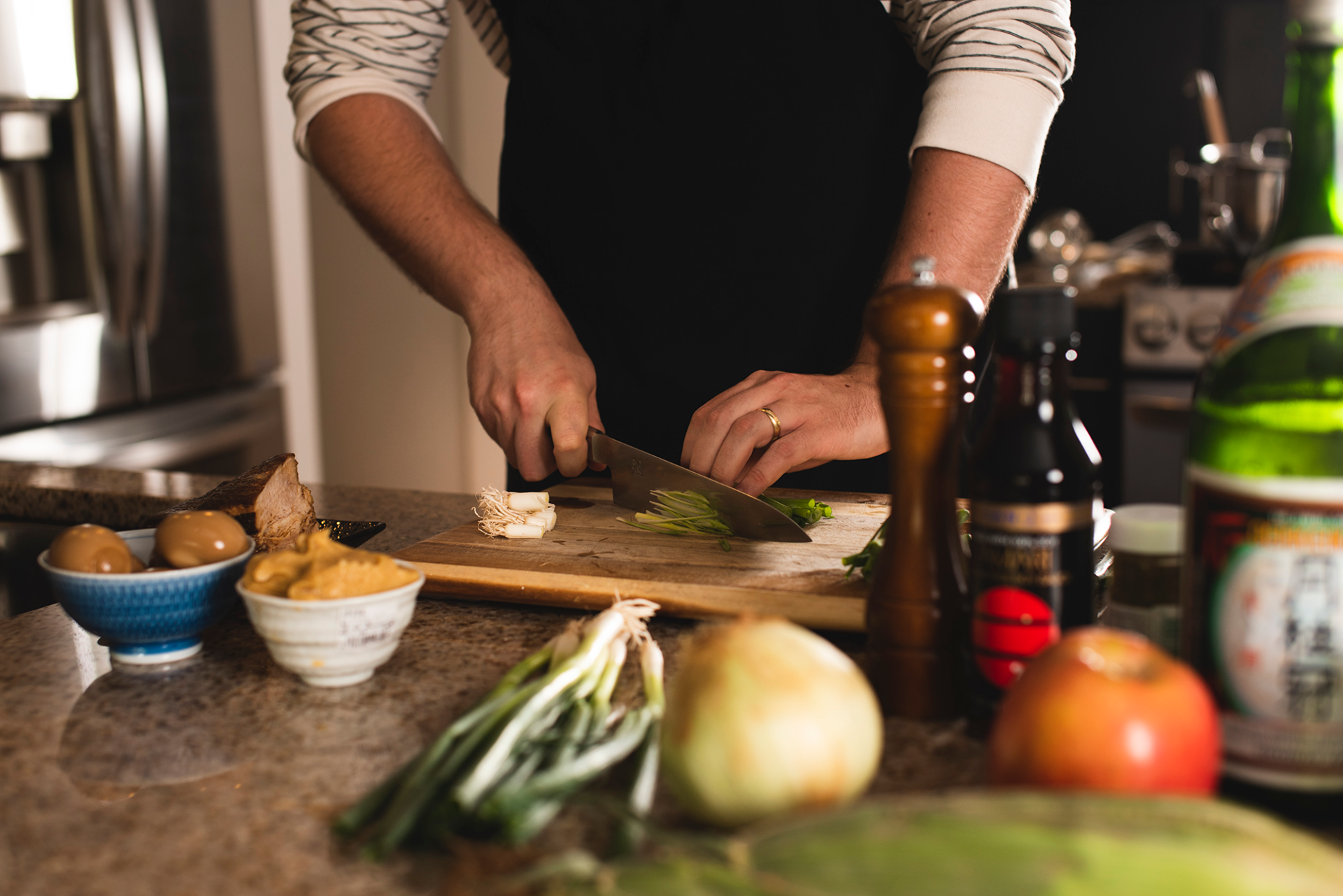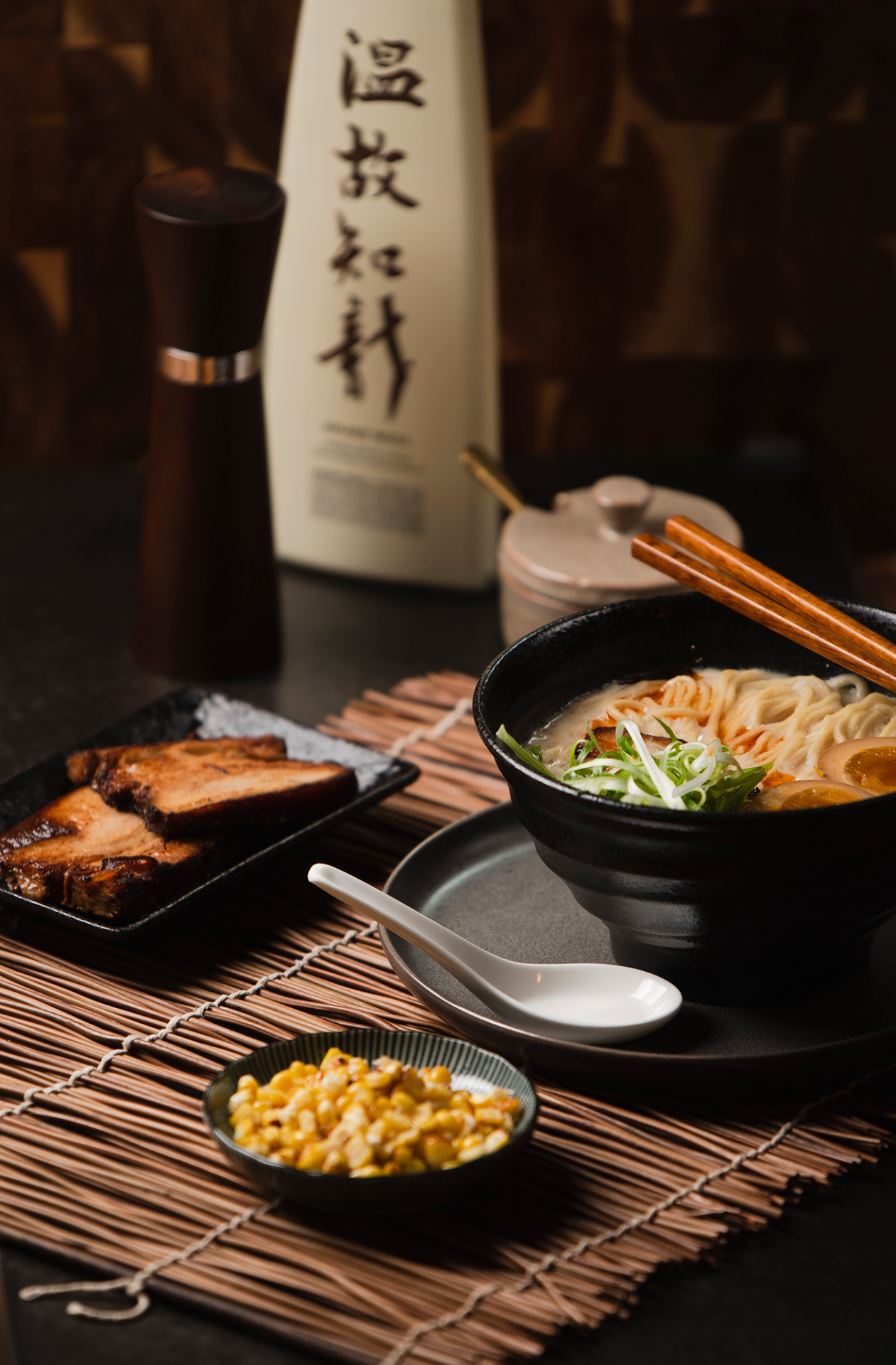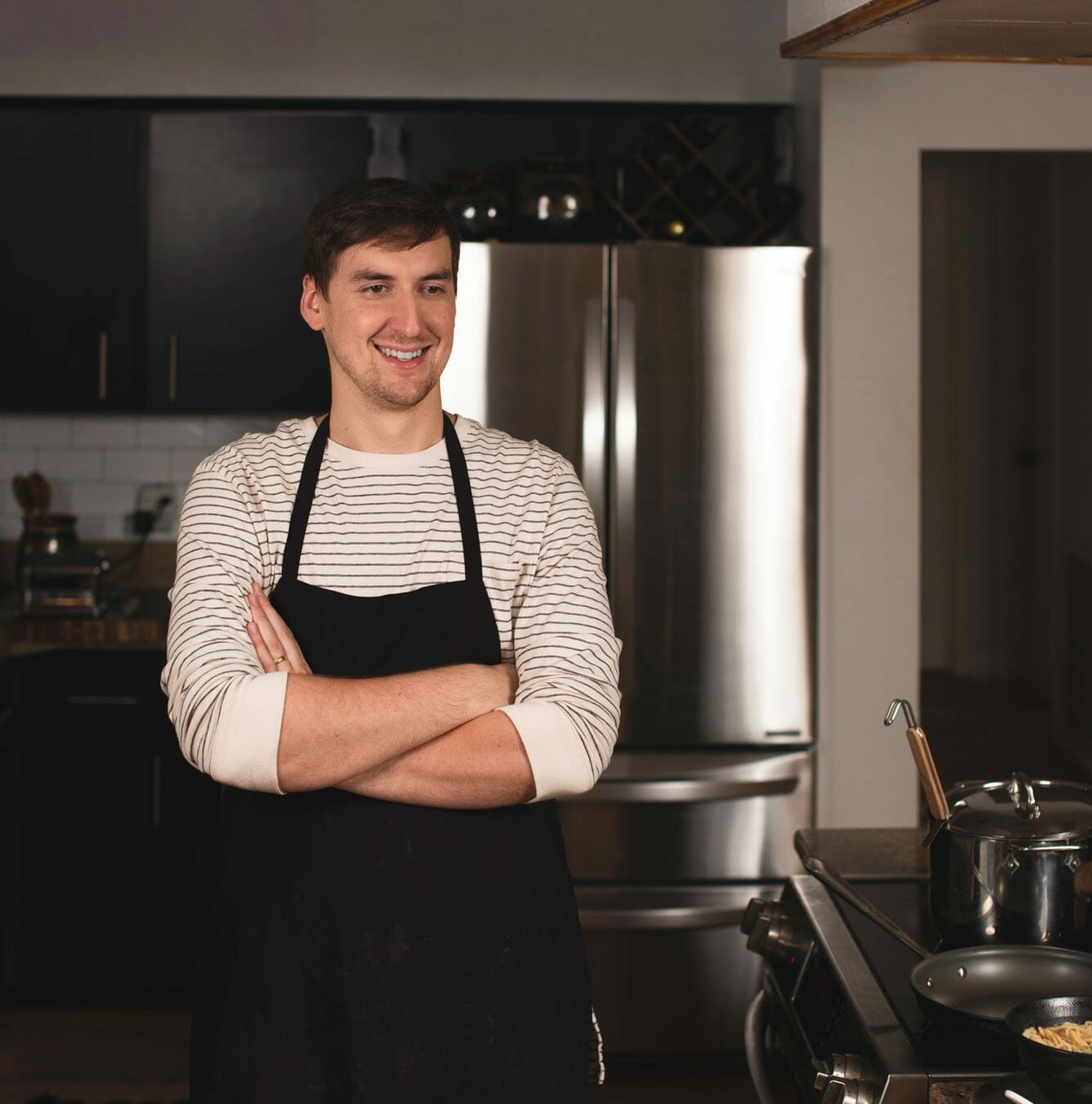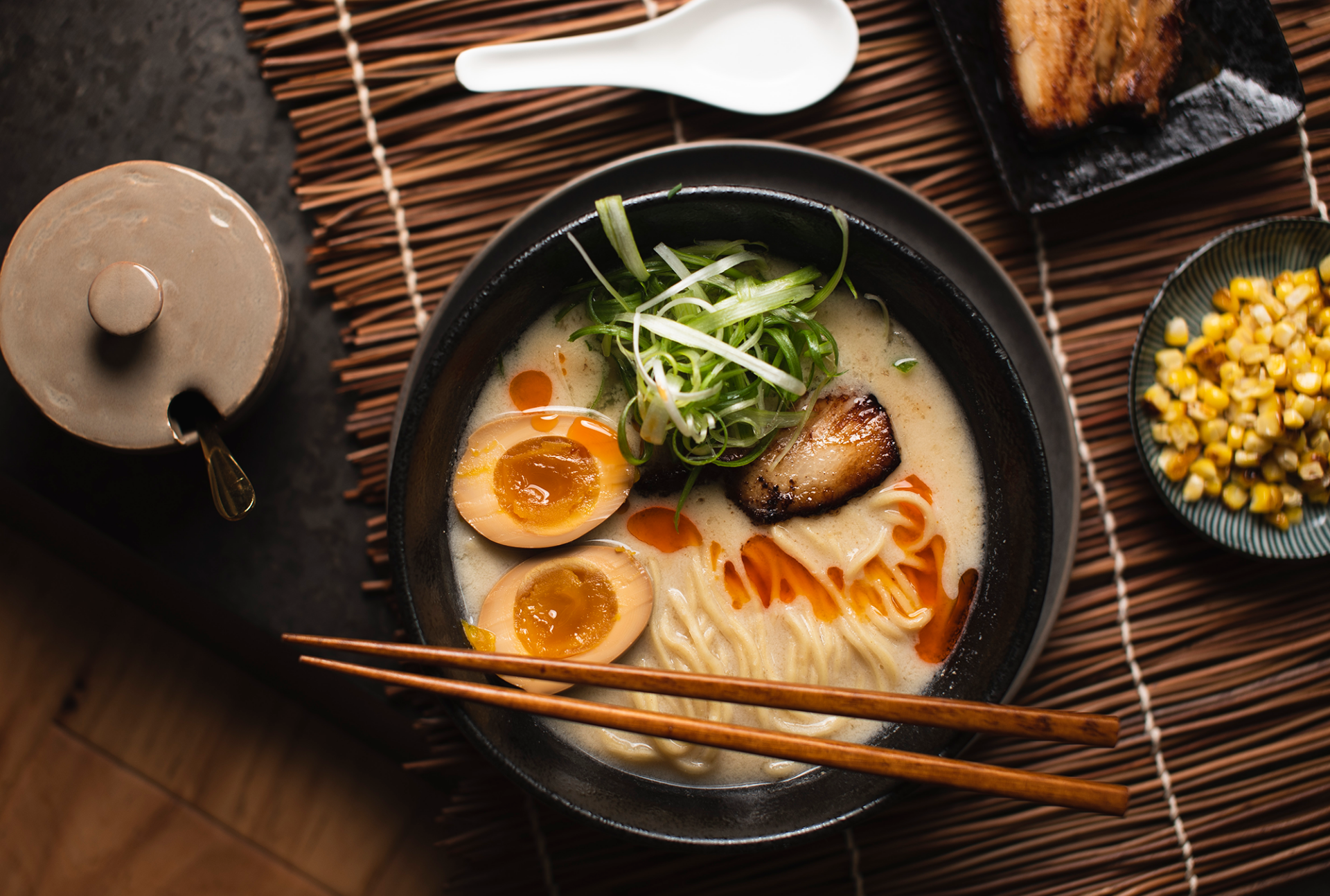Photography by Daniel Barceló
A new food delicacy is coming to Lakeland. With plans of opening a Japanese-inspired ramen restaurant, Ryan Neal hopes to provide an experience for clientele while contributing to the local food culture. A variety of seasonal and special ramens will be offered, from traditional tonkatsu ramen to miso vegan ramen.
Memories are often created over a meal. When we eat certain foods, such as ramen, it can often be attributed to an experience. With just a slight taste of ramen, we can recall our college days of making the noodles in our dorm rooms. For others, it’s a reminder of trying something from a different country — the taste of ramen bringing to life an Asian delicacy with the fusion of flavors found in a bowl of noodles served in hot broth with slices of meat.
When Ryan Neal opens a ramen restaurant by the end of 2019, he hopes to provide Lakelanders with an experience — whether it’s trying something new or expanding their palates. A Florida native, Neal describes himself as a food ambassador who encourages others to try new foods. “I hope people experience something that they might not have had or thought they would have liked when they come to Sābu Ramen. I hope to present things that people might not generally eat. I have always loved trying new things.”
 Naming the restaurant after the Japanese word for servant, sābu, Neal desires to incorporate a heart of service behind every bowl of ramen he makes. “I really felt called to service and servanthood, and, especially in my professional life, to serve my employees and to serve them through my sacrifice. That’s kind of my ideology for the restaurant.”
Naming the restaurant after the Japanese word for servant, sābu, Neal desires to incorporate a heart of service behind every bowl of ramen he makes. “I really felt called to service and servanthood, and, especially in my professional life, to serve my employees and to serve them through my sacrifice. That’s kind of my ideology for the restaurant.”
With a heart for serving others, Neal originally enrolled in a ministry training school in Georgia before returning home to Lakeland to work in different kitchens. For the next few years, he spent time learning to refine his culinary skills in various restaurants in Lakeland and Tampa, while developing a passion for cooking ramen.
Neal’s fascination with ramen derived from watching anime at a young age. “It was kind of like a hobby for me. I would watch Japanese anime shows. The ramen looked really good. So I started to just make it.” The ramen from the shows piqued his interest enough to start experimenting with different recipes at home. “I started to test recipes and make my own noodles and broth. It’s something I became interested in doing. Cooking is really something that I have loved to do since I was young.”
Using a recipe he found online, Neal made his first batch of noodles from scratch at home, mixing together water, flour, salt, and alkaline. His experiments didn’t stop there. He purchased more than 10 different books with ramen recipes and continued to make a variety of ramen recipes at home.
“I really felt called to service and servanthood, and, especially in my professional life, to serve my employees and to serve them through my sacrifice. That’s kind of my ideology for the restaurant.”
Although Neal didn’t enroll in culinary school, he spent years learning from working in kitchens and under local chefs. He first started in the kitchen at Black & Brew Coffee House and Bistro, where he worked as the kitchen manager for two years. From there, he went to work under local Chef Marcos Fernandez at Nineteen61. At the restaurant, Neal worked in the kitchen helping prepare the food and assisting with the dining service.
“I wasn’t going to go to culinary school. I wanted to work somewhere where I could get confidence and a better understanding of food,” Neal says. He shares how valuable it was for him to work alongside Chef Marcos. He was even given the opportunity to serve some of his ramen recipes for a limited time on the restaurant’s lunch menu.
A year later, Neal went to work at Ichicoro Ramen, a Japanese craft ramen restaurant in Tampa. During his time there, Neal learned everything he could about ramen while he worked in the preparation line. As he continued to develop his culinary skills and his passion for ramen grew, Neal decided that he wanted to open a ramen shop in Lakeland. He soon left working at Ichicoro and started to plan for his own ramen restaurant.
[modula id=”19496″]
Neal and his wife traveled to Japan to learn more about Japanese ramen through exploring its origins.
Before Neal opened his restaurant, he believed it was essential to learn more about Japanese ramen through exploring its origins. “I think it’s important to figure out the roots of ramen through culinary adventures,” Neal explains as he shares how he recently took a trip to Japan with his wife. “It was important to go and see where it was from and how it was made there. I love Japanese culture, and my wife does, too. A lot of it was preparation for the restaurant and learning about ramen.”
On his trip, Neal delved into learning everything he could about ramen and its roots. Originating from China, ramen was introduced to Japan in the 19th century. Neal explains how the Japanese put their own flair into their ramen, using miso and soy, instead of the salt-based broth found in China.
“The use of miso started in the Sapporo region in northern Japan, where it is so cold. It is a hardy, warming type of broth. They would have it there a lot. Although it started there, it’s all over Japan now. The Japanese people are also known for soy and the craftsmanship of their soy sauce,” Neal says. He adds that there are four fundamental different types of broths used in ramen: miso, shoyu (soy-based), shio (salt-based) and tonkatsu (pork-based).
 While in Japan, Neal tried to learn everything he could about Japanese culture in the two weeks he and his wife were there. His research for making ramen included eating ramen every day and exploring a variety of Japanese street foods. He says they “went hoping to experience what it’s supposed to be like.” He adds how “the packet of noodles we purchase in America is a cheap, condensed version of what they make in Japan. The ramen in Japan is on another level.”
While in Japan, Neal tried to learn everything he could about Japanese culture in the two weeks he and his wife were there. His research for making ramen included eating ramen every day and exploring a variety of Japanese street foods. He says they “went hoping to experience what it’s supposed to be like.” He adds how “the packet of noodles we purchase in America is a cheap, condensed version of what they make in Japan. The ramen in Japan is on another level.”
One aspect of their trip that Neal hopes to incorporate into his menu is some dishes inspired by Japanese street food. “It was definitely a trip where we got to taste different food and to try to get new ideas for the menu. A key focus was to try all the different street foods we could find. All over the place, they have booths set up and tons of street food.”
Right now, Neal is perfecting a variety of ramen recipes in his kitchen at home. “One thing that I am really passionate about and want to provide is to make sure that everything is homemade. I want to do something that is good and will keep people coming back. I also want to provide something that is affordable.”
When the restaurant opens in Lakeland, it will include a few bowls of ramen with a flare of Japanese street food options. Neal plans to incorporate specials and seasonal dishes as well. The three main ramen options that will be on the menu are a tonkatsu (pork-based) ramen, a chicken shio (salt-based) ramen, and vegan miso ramen. “I want to have a street food menu where people can try new things,” he says.
Sābu Ramen will be open to serve lunch and dinner.
Although Neal is in the early talks of his restaurant, he has plans of it being a part of The Joinery in Lakeland. “There is a lot of growth happening in Lakeland. I hope to contribute to the food movement here. I am excited to be a part of what could be a revolution in the food culture of Lakeland.”
Sābu Ramen has been confirmed as one of the vendors taking up a larger space in The Joinery, a modern food hall opening soon.
Sweet Miso Ramen
Miso Tare
2-1/2 pounds fettuccine pasta (break into 1-1/2 to 2-inch pieces) (can be made with gluten-free pasta as well)
2 cups white (shiro) miso
1 large yellow onion, diced
1 sweet apple, peeled and diced
5 cloves of garlic, minced
1-inch knob of ginger, peeled and minced
1/2 cup sake
1/2 cup mirin
1 tablespoon kosher salt
2 tablespoon sugar
1/2 cup neutral oil (canola, vegetable, grapeseed)
Dashi
5×5-inch piece of kombu (dried seaweed)
1 cup dried bonito flakes (katsuobushi)
2 quarts water
Simple Alkaline Noodle
1 teaspoon baked-baking soda (see instructions)
1 cup cold water
1½ teaspoons kosher salt
4 cups bread flour
Cornstarch for rolling
Soy-Braised Pork Belly
2- to 3-pound slab pork belly (skin on)
2 cups soy sauce
1/2 cup mirin
1/2 cup sake
1-inch knob ginger, roughly chopped
5 cloves garlic, smashed
Water
Other Ramen Toppings
2- to 3-pound slab pork belly (skin on)
Green onions
Chili oil
Grilled corn
Bamboo shoots
Making the Tare
Place oil in a deep sauté pan along with the diced apple and onion. Cook on medium to medium-low until onions and apples are translucent, but don’t allow them to brown (about 10 minutes). Then add garlic and ginger and cook for 6-8 minutes. At this point, turn up the temperature and add the sake and mirin to deglaze the pan. Let it reduce by half, then turn off the heat. Let it cool slightly, then put in a blender along with the salt and sugar. Blend to make it as smooth as possible. Add all of this back into the pan and then add the miso on medium-low heat. Whisk everything together thoroughly. Let it simmer for only a couple of minutes (very carefully as it will burn very easily). Once ready, move to a container to let it cool. If kept in the fridge, this will be good for about two weeks.
Making the Dashi
Place the kombu in a stock pot with 2 quarts of water on medium-high heat. Bring the water to 180°F, before it begins to boil. Cut off the heat, cover with a lid, and let sit for 30 minutes. Remove the kombu and add the katsuobushi. I like to wrap the katsuobushi in a coffee filter and tie it, essentially making a tea bag. Leave it in the water for 20 minutes and then remove and strain out the katsuobushi (if you didn’t make a tea bag with it). Try to ring out the water from the katsuobushi into the dashi to get all the traces of flavor. Place in fridge, if using later.
[modula id=”19502″]
“There is a lot of growth happening in Lakeland. I hope to contribute to the food movement here. I am excited to be a part of what could be a revolution in the food culture of Lakeland.”
Pork Belly
Start by finding a deep-sided pan that will have the snuggest fit for the slab of belly. Turn the pan on medium-high heat and let it get a little hot. Add sake, let it cook for 2 minutes, enough for the alcohol to cook out. Add the mirin, and simmer for 2 minutes. Add everything else except the belly, and let it come to a simmer. Simmer for 5 minutes. Add the belly and enough water to just cover the belly, and let it come to a simmer. Turn the heat down to low, cover, and let it go for 2-3 hours. You want it to stay at a very low simmer, flipping the slab over every 30 minutes or so to help color both sides. At first, the belly will feel extremely tough and firm. But after 2 hours, you will notice it getting more and more tender. The longer you let it go, the more tender it will get. But about 3 hours is where I like it. If you leave it on too long, you’ll just have shredded pork belly, so be careful. Take the pork off the heat, and it is ready to serve! Ideally, you should leave the pork in the braising liquid and cool in the fridge overnight. This will help it not dry out, as well as make it easier to slice for the ramen. If you do this, just reheat in a skillet with oil.
Simple Alkaline Noodle
To make the baked-baking soda: Set oven to 275°F. Place baking soda on a baking sheet, and put in the oven for 1 hour. You can put as much baking soda as you need in the oven for this. Once it’s baked, it stays good for a long time. So you can save it to make more noodles another day!
For the noodles, you will want to use a stand mixer with the hook attachment. If you don’t have one, get ready for a workout. Also, you should have a pasta machine; otherwise making this will be very difficult. Sift the flour into the mixer bowl. Mix the baked soda along with the salt into the cup of water and slowly into the flour. While you are doing this, have the mixer going to incorporate. Once the water is completely added, turn up the speed, scraping the sides of the bowl to get the clinging flour and dough. If the dough isn’t coming together, add a tablespoon of water at a time, making sure you don’t add too much. Adding too much means the dough will be sticky. You want a slightly moist dough, but not sticky. If you add too much water, simply add a little more flour. Mix on medium-low speed for 10 minutes. The dough should be making a loose ball at this point. Remove dough from the bowl and cover it with a kitchen towel, letting it rest for 30 minutes.
Rolling the noodles: Divide the dough into 4 even pieces to make rolling easier. Keep some cornstarch handy to help the dough not stick to your rolling machine. Roll the dough into thin sheets, either the thinnest or second-thinnest setting unless you specifically want really thick noodles. Then use the pasta-cutting attachment (whatever size you want, for normal noodles use the thin side) and roll the noodles through the cutter. This recipe makes about 6-8 portions worth of noodles. Cook the noodles for 2-4 minutes at a heavy boil. The time depends on how firm you want the noodles; the less time, the more firm your noodles will come out.

 “I really felt called to service and servanthood, and, especially in my professional life, to serve my employees and to serve them through my sacrifice. That’s kind of my ideology for the restaurant.”
“I really felt called to service and servanthood, and, especially in my professional life, to serve my employees and to serve them through my sacrifice. That’s kind of my ideology for the restaurant.”